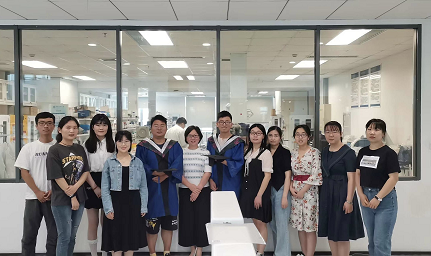1. Educational Experience
(1) 2008/09-2013/07,College of Pharmacy, China Pharmaceutical University, Ph.D
(2) 2004/09-2008/07, College of Pharmacy, China Pharmaceutical University, Bachelor Degree
2. Working Experience
(1) 2017/07 - now, Associate Professor, College of Pharmacy, China Pharmaceutical University
(2) 2013/07-2017/06, College of Pharmacy, China Pharmaceutical University, Lecturer
(2) 2015/11-2017/02, Postdoctoral Fellow, College of Pharmacy, University of North Carolina at Chapel Hill
1. Pharmacometrics: PBPK, PK/PD QSP, PopPK models
2. Model informed drug development
3. Model informed precision dosing
1. Research Projects
(1) Prediction of cardiotoxicity of antitumor drugs in vitro and in vivo based on QSP-PBPK-TD model, 2020/01/01-2023/12/31, 540,000 Yuan, in progress, J
(2) Establishment of a risk prediction model based on Bayesian networks for cardiotoxicity assessment of VEGF receptor inhibitors, 2016/01/01-2018/12/1, 170,000 yuan, concluded, J
2. Representative Research Achievements
(1) PBPK-PD model was used to investigate the relationship between the properties of liposome and its pharmacokinetics/pharmacodynamics
Liposomal preparations play the role of enhancing efficacy and reducing toxicity through targeted delivery of loaded drugs to the target, and their properties are the key to determining the efficiency and efficacy of drug delivery. In this project, doxorubicin liposomes were taken as an example to establish the PBPK model of liposomes and doxorubicin, and Krogh model was combined to describe the heterogeneous distribution of drugs in tumor tissues. The relationship between the size of liposome, surface charge, PEG content, drug release rate and diffusion rate in tumor tissue and the distribution and antitumor activity of doxorubicin tumor tissue was quantitatively analyzed. The project was funded by the FDA to provide a reference for the FDA's standard review of liposome generic drugs.
(2) Prediction of cardiotoxicity of antitumor drugs based on QSP-PBPK-PD model
Some drugs may cause cardiac function injury while performing antitumor therapy, and eventually lead to tumor patients' discontinuation of treatment or inducing heart disease. In this project, the interaction between cardiotoxic drugs and cardiomyocytes was studied by human cardiomyocytes in vitro, the in vivo disposal process of drugs and the feedback regulation of cardiovascular system were studied by animal experiments, and the QSP-PBPK-PD model was established by means of in vitro and in vivo and interspecies comparison method. The relationship between drug disposal, cell sensitivity to drugs and the feedback of the body's own cardiovascular system and the occurrence of cardiotoxicity was quantitatively analyzed to predict the incidence of cardiotoxicity of cardiotoxic drugs in different populations.
1. Gong F.; Hu H.; Ouyang Y.; Liao Z.; Kong Y.; Hu J.; He, H.*; Zhou Y. Physiologically-based pharmacokinetic modeling-guided rational combination of tacrolimus and voriconazole in patients with different CYP3A5 and CYP2C19 alleles. Toxicol Appl Pharmacol.2023; 466: 116475. (IF: 4.46)
2. Sang, L.; Yuan, Y.; Zhou, Y.; Zhou, Z.Y.; Jiang, M.H.; Liu, X.Q.; Hao, K.; He, H. * A quantitative systems pharmacology approach to predict the safe-equivalent dose of doxorubicin in patients with cardiovascular comorbidity. CPT Pharmacometrics Syst Pharmacol. 2021;10,12: 1512-1524. (IF: 4.054)
3.Zhou, Z.Y.; Zhu, J.W.; Jiang, M.H.; Sang, L.; Hao, K.; He, H.* The Combination of Cell Cultured Technology and In Silico Model to Inform the Drug Development. Pharmaceutics. 2021; 13,5:704. (IF: 6.321)
4.Liu, H.C.; Zhou, X.T.; Zheng, Y.S.; He, H.*; Liu, X.Q. PK/PD modeling based on NO-ET homeostasis for improving management of sunitinib-induced hypertension in rats. Acta Pharmacol Sin. 2020;41,5: 719-728. (IF: 5.064)
5.He, H.; Liu, C.; Liu, Y.H.; Liu, X.Q.; Wu, Y.; Fan, J.H.; Zhao, L.; Cao, Y.G. Mathematical modeling of the heterogeneous distributions of nanomedicines in solid tumors. Eur J Pharm Biopharm. 2019;142:153-164. (IF: 4.708)
6.He, H.; Yuan, D.F.; Wu, Y.; Cao, Y.G. Pharmacokinetics and Pharmacodynamics Modeling and Simulation Systems to Support the Development and Regulation of Liposomal Drugs. Pharmaceutics. 2019;11,3: 110. (IF: 4.773)
7.He, H.; Liu, C.; Wu, Y.; Zhang, X.Y.; Fan, J.H.; Cao, Y.G. A Multiscale Physiologically-Based Pharmacokinetic Model for Doxorubicin to Explore its Mechanisms of Cytotoxicity and Cardiotoxicity in Human Physiological Contexts. Pharm Res. 2018;35,9:174. (IF: 3.335)
8.He, H.; Cao, Y.G. Chemotherapeutic dosing implicated by pharmacodynamic modeling of in vitro cytotoxic data: a case study of paclitaxel. J Pharmacokinet Pharmacodyn. 2017; 44,5: 491-501. (IF: 1.673)
9.Wang, H.D.; Li, X.; Zhang, W.T.; Liu, Y.; Wang, S.J.; Liu, X.Q.; He, H.* Mechanism-based pharmacokinetic-pharmacodynamic modeling of salvianolic acid A effects on plasma xanthine oxidase activity and uric acid levels in acute myocardial infarction rats. Xenobiotica. 2017;47,3: 208-216. (IF: 1.932)
10.Wang, H.D.; Jiang, H.; Liu, H.C.; Zhang, X.; Ran, G.M.; He, H.*; Liu, X.Q. Modeling Disease Progression: Angiotensin II Indirectly Inhibits Nitric Oxide Production via ADMA Accumulation in Spontaneously Hypertensive Rats. Front Physiol. 2016; 7: 555. (IF: 4.031)




